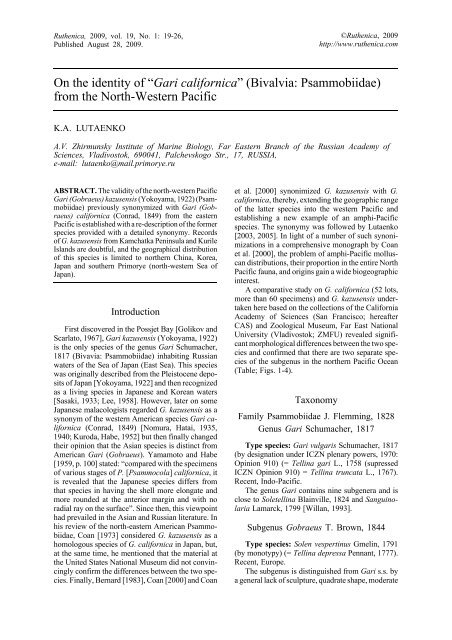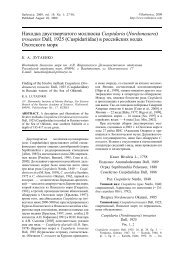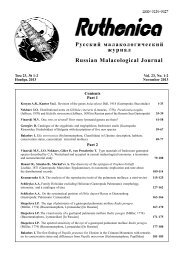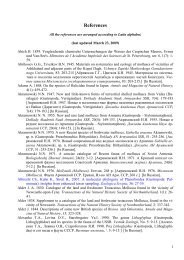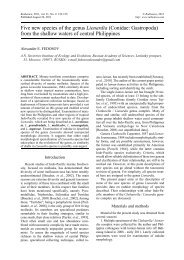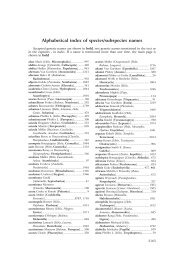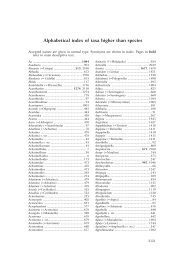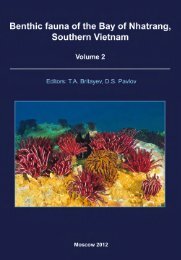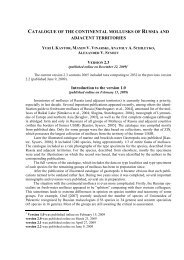Gari californica - Ruthenica, Russian Malacological Journal
Gari californica - Ruthenica, Russian Malacological Journal
Gari californica - Ruthenica, Russian Malacological Journal
- No tags were found...
Create successful ePaper yourself
Turn your PDF publications into a flip-book with our unique Google optimized e-Paper software.
<strong>Ruthenica</strong>, 2009, vol. 19, No. 1: 19-26,Published August 28, 2009.©<strong>Ruthenica</strong>, 2009http://www.ruthenica.comOn the identity of “<strong>Gari</strong> <strong>californica</strong>” (Bivalvia: Psammobiidae)from the North-Western PacificK.A. LUTAENKOA.V. Zhirmunsky Institute of Marine Biology, Far Eastern Branch of the <strong>Russian</strong> Academy ofSciences, Vladivostok, 690041, Palchevskogo Str., 17, RUSSIA,e-mail: lutaenko@mail.primorye.ruABSTRACT. The validity of the north-western Pacific<strong>Gari</strong> (Gobraeus) kazusensis (Yokoyama, 1922) (Psammobiidae)previously synonymized with <strong>Gari</strong> (Gobraeus)<strong>californica</strong> (Conrad, 1849) from the easternPacific is established with a re-description of the formerspecies provided with a detailed synonymy. Recordsof G. kazusensis from Kamchatka Peninsula and KurileIslands are doubtful, and the geographical distributionof this species is limited to northern China, Korea,Japan and southern Primorye (north-western Sea ofJapan).IntroductionFirst discovered in the Possjet Bay [Golikov andScarlato, 1967], <strong>Gari</strong> kazusensis (Yokoyama, 1922)is the only species of the genus <strong>Gari</strong> Schumacher,1817 (Bivavia: Psammobiidae) inhabiting <strong>Russian</strong>waters of the Sea of Japan (East Sea). This specieswas originally described from the Pleistocene depositsof Japan [Yokoyama, 1922] and then recognizedas a living species in Japanese and Korean waters[Sasaki, 1933; Lee, 1958]. However, later on someJapanese malacologists regarded G. kazusensis as asynonym of the western American species <strong>Gari</strong> <strong>californica</strong>(Conrad, 1849) [Nomura, Hatai, 1935,1940; Kuroda, Habe, 1952] but then finally changedtheir opinion that the Asian species is distinct fromAmerican <strong>Gari</strong> (Gobraeus). Yamamoto and Habe[1959, p. 100] stated: “compared with the specimensof various stages of P. [Psammocola] <strong>californica</strong>, itis revealed that the Japanese species differs fromthat species in having the shell more elongate andmore rounded at the anterior margin and with noradial ray on the surface”. Since then, this viewpointhad prevailed in the Asian and <strong>Russian</strong> literature. Inhis review of the north-eastern American Psammobiidae,Coan [1973] considered G. kazusensis as ahomologous species of G. <strong>californica</strong> in Japan, but,at the same time, he mentioned that the material atthe United States National Museum did not convincinglyconfirm the differences between the two species.Finally, Bernard [1983], Coan [2000] and Coanet al. [2000] synonimized G. kazusensis with G.<strong>californica</strong>, thereby, extending the geographic rangeof the latter species into the western Pacific andestablishing a new example of an amphi-Pacificspecies. The synonymy was followed by Lutaenko[2003, 2005]. In light of a number of such synonimizationsin a comprehensive monograph by Coanet al. [2000], the problem of amphi-Pacific molluscandistributions, their proportion in the entire NorthPacific fauna, and origins gain a wide biogeographicinterest.A comparative study on G. <strong>californica</strong> (52 lots,more than 60 specimens) and G. kazusensis undertakenhere based on the collections of the CaliforniaAcademy of Sciences (San Francisco; hereafterCAS) and Zoological Museum, Far East NationalUniversity (Vladivostok; ZMFU) revealed significantmorphological differences between the two speciesand confirmed that there are two separate speciesof the subgenus in the northern Pacific Ocean(Table; Figs. 1-4).TaxonomyFamily Psammobiidae J. Flemming, 1828Genus <strong>Gari</strong> Schumacher, 1817Type species: <strong>Gari</strong> vulgaris Schumacher, 1817(by designation under ICZN plenary powers, 1970:Opinion 910) (= Tellina gari L., 1758 (supressedICZN Opinion 910) = Tellina truncata L., 1767).Recent, Indo-Pacific.The genus <strong>Gari</strong> contains nine subgenera and isclose to Soletellina Blainville, 1824 and SanguinolariaLamarck, 1799 [Willan, 1993].Subgenus Gobraeus T. Brown, 1844Type species: Solen vespertinus Gmelin, 1791(by monotypy) (= Tellina depressa Pennant, 1777).Recent, Europe.The subgenus is distinguished from <strong>Gari</strong> s.s. bya general lack of sculpture, quadrate shape, moderate
20 K.A. LutaenkoFIG. 1. A-D — <strong>Gari</strong> (Gobraeus) <strong>californica</strong> (Conrad, 1849), outer (A, C) and inner (B, D) views of the same shell,California, San Diego, CAS no. 4707, I.S. Oldroyd Colln., length 53.1 mm; E-H — G. (G.) <strong>californica</strong> (Conrad,1849), outer (E, G) and inner (F, H) views of the same shell, California, San Diego, CAS no. 4707, I.S. OldroydColln., length 97.5 mm.РИС. 1. A-D — <strong>Gari</strong> (Gobraeus) <strong>californica</strong> (Conrad, 1849), вид снаружи (A, C) и изнутри (B, D) одной и тойже раковины, Калифорния, Сан-Диего, CAS № 4707, коллекция И.Ш. Олдройд, длина раковины 53,1 мм;E-H — G. (G.) <strong>californica</strong> (Conrad, 1849), вид снаружи (E, G) и изнутри (F, H) одной и той же раковины,Калифорния, Сан-Диего, CAS № 4707, коллекция И.Ш. Олдройд, длина раковины 97,5 мм.
On “<strong>Gari</strong> <strong>californica</strong>” from NW Pacific 21posterior gape and lack of a posterior ridge [Willan,1993]. There are two species in the temperate easternPacific Ocean: G. (G.) <strong>californica</strong> (Conrad, 1849)and G. (G.) fucata (Hinds, 1845) [Coan, 2000; Coanet al., 2000]. Worldwide, there are 13 species [Willan,1993] that occur in Europe, west Africa, theeastern and western Pacific, and Australasia.<strong>Gari</strong> (Gobraeus) kazusensis(Yokoyama, 1922)Figs. 3A-G; 4Psammobia kazusensis Yokoyama, 1922: 136, pl. 9, fig.4; Yokoyama, 1926: 210; Sasaki, 1933: 12, pl. 2,fig. 11.<strong>Gari</strong> (Gobraeus) <strong>californica</strong>; Nomura, Hatai, 1935: 17;Coan, 2000 (part.): 3, fig. 2; Lutaenko, 2003: 19;Lutaenko, 2005: 74, pl. 7, figs. S, W (non Conrad,1849).<strong>Gari</strong> <strong>californica</strong>; Nomura, Hatai, 1940: 84; Kuroda, Habe,1952: 20; Bernard, 1983 (part.): 47; Lutaenko et al.,2002: 30 (non Conrad, 1849).Psammocola kazusensis; Lee, 1958: 9, pl. 6, figs. 9, 10,13; Kira, 1959: 153, pl. 59, fig. 5; Yamamoto, Habe,1959: 100, pl. 10, figs. 3, 4; Zhao et al., 1982: 121,pl. 17, fig. 5; Habe, 1970: 160, pl. 60, fig. 15; Kwonet al., 1993: 377, fig. 90-3 [as kazuensis].Psammocola kazusensis atsumiensis Hayasaka, 1961: 54,pl. 7, figs. 1, 2.<strong>Gari</strong> (Psammocola) kazusensis; Golikov, Scarlato, 1967:117, fig. 98.Gobraeus kazusensis; Habe, 1977: 220, pl. 47, figs. 2,3; Yamaguchi et al., 1987: 73, pl. C-24, fig. 12 [askazuensis]; Qi et al., 1989: 207, pl. 12, fig. 9; Bernardet al., 1993: 98; Huang, 1994: 406; Tsichida, Kurozumi,1995: 30, pl. 5, fig. 10; Xu, 1997: 180; Higoet al., 1999: 494; Matsukuma, 2000: 987, pl. 491,fig. 7; Kwon et al., 2001: 259, fig. 1053; Lee, Min,2002: 164; Min et al., 2004: 451, fig. 1485; Wang,2004: 293, pl. 159, fig. E; Min et al., 2005: 175,fig. 465; Xu, Zhang, 2008: 207, fig. 645.<strong>Gari</strong> (Gobraeus) kazusensis; Oyama, 1980: 110, pl. 50,fig. 11; Scarlato, 1981: 367, text-fig. 190; Kafanov,1991: 77; Scarlato, Kafanov, 1988: 940.<strong>Gari</strong> kazusensis; Volova, Scarlato, 1980: 81, fig. 80; Evseev,1981: 114; Yavnov, 2000: 135, photo; Kantor,Sysoev, 2005: 361; Evseev, Yakovlev, 2006: 91, photo.Type material: A syntype of Psammobia kazusensisYokoyama, 1922 is in the University Museum,University of Tokyo, no. CM21262 (one valve)(illustrated in: [Coan, 2000, fig. 2]), type locality —Upper Musashino Formation (Pleistocene) at Shito,Ichihara-gun, Chiba Pref., Japan; holotype (no. IGPS78419, one valve) and a paratype (no. IGPS 78420,one valve) of Psammocola kazusensis atsumiensisHayasaka, 1961 are in the Institute of Geology andPaleontology, Tohoku University, type locality —“Tonna Bed” and “Mya Bed” (Pleistocene) at Takamatsu,Atsumi Peninsula, Aichi Prefecture, Japan.Material examined: more than 30 specimens(ZMFU and author’s collection).Description: Shell ovate-subquadrate to ovateelongate,moderately large, thin, eqivalve, ratherflattened, white; outer surface rather smooth, withfine commarginal growth lines, slightly flattenednear postero-dorsal margin; periostracum brownish,light in young specimens. Postero-dorsal and antero-dorsalmargins broadly rounded but the formerone sometimes nearly straight, ventral margin alsonearly straight. Beaks small, low, placed nearly midpointof dorsal margin. Nymph heavy, higher posteriorly.Right valve with anterior cardinal and narrowposterior cardinal teeth, left valve with narrow,weak anterior cardinal and narrow posterior cardinalteeth. Pallial sinus moderately deep, rounded, broad,nearly reaching to below the beaks. Adductor scarsovate, the anterior one more narrow and posteriorbroader.Remarks: This species is clearly differentiatedfrom G. <strong>californica</strong> by more elongated shell shape,broadly rounded anterior end, complete absence ofradial color rays on shell surface and smaller size(Table, see also Figs. 1-3; holotype of G. <strong>californica</strong>is figured by Coan [2000, fig. 1]). Although additionalmolecular genetic analysis is needed to supportthis opinion, morphological differences are quiteobvious.Distribution and ecology: This species is knownfrom Yellow and Bohai seas — Liaoning and Shan-Table. Morphological comparison between <strong>Gari</strong> <strong>californica</strong> and <strong>Gari</strong> kazusensisТаблица. Морфологическое сравнение <strong>Gari</strong> <strong>californica</strong> и <strong>Gari</strong> kazusensisMorphological characters <strong>Gari</strong> <strong>californica</strong> <strong>Gari</strong> kazusensisShell convexity Moderately inflated Rather flattenedColorYellowish-tan with purple radial White, no color rays presentraysPosition of beaks from anterior end 36-40% 42-50%Antero-dorsal margin Rather short, nearly straight Longer than in G. <strong>californica</strong>,more subparallel to ventral marginAnterior end Sharply rounded Broadly roundedAnterior cardinal of left valve Moderate, nearly vertical Narrow, weak, slightly posteriorlydirectedMaximum size (length), mm 141.0 [Coan, 2000] 73.1 (up to 80 — [Yokoyama,1922])
22 K.A. LutaenkoFIG. 2. A-D — <strong>Gari</strong> (Gobraeus) <strong>californica</strong> (Conrad, 1849), inner (A, C) and outher (B, D) views of the same shell,California, Monterey, CAS no. 29352, E. Rixford Colln., length 54.5 mm; E-H — G. (G.) <strong>californica</strong> (Conrad,1849), outer (E, G) and inner (F, H) views of the same shell, California, Monterey Co., Pacific Grove, HopkinsMarine Station, CAS cat. no. 115850 (acc. no. 52575), M.K. Wicksten Colln., length 93.3 mm.РИС. 2. A-D — <strong>Gari</strong> (Gobraeus) <strong>californica</strong> (Conrad, 1849), вид изнутри (A, C) и снаружи (B, D) одной и тойже раковины, Калифорния, Монтерей, CAS № 29352, коллекция Э. Риксфорд, длина раковины 54,5 мм; E-H— G. (G.) <strong>californica</strong> (Conrad, 1849), вид снаружи (E, G) и изнутри (F, H) одной и той же раковины,Калифорния, округ Монтерей, Пасифик Гров, Морская станция Гопкинса, CAS № 115850 (№ поступления52575), коллекция М.К. Викстен, длина раковины 93,3 мм.
On “<strong>Gari</strong> <strong>californica</strong>” from NW Pacific 23FIG. 3. <strong>Gari</strong> (Gobraeus) kazusensis (Yokoyama, 1922), outer (A, C) and inner (B, D) views of the same shell, Seaof Japan, Peter the Great Bay, Reineke Isl., ZMFU no. 10857/Bv-1090, length 52.0 mm; E-F — G. (G.) kazusensis(Yokoyama, 1922), outer (E) and inner (F) views of the same shell, Sea of Japan, Peter the Great Bay, ReinekeIsl., ZMFU no. 10857/Bv-1090, length 63.4 mm; G — G. (G.) kazusensis (Yokoyama, 1922), outer view, Sea ofJapan, Ussuriysky Bay, Sukhodol Bay, Inst. Mar. Biol. FEB RAS Colln., length 74.3 mm.FIG. 3. A-D — <strong>Gari</strong> (Gobraeus) kazusensis (Yokoyama, 1922), вид снаружи (A, C) и изнутри (B, D) одной и тойже раковины, Японское море, залив Петра Великого, о-в Рейнеке, ZMFU № 10857/Bv-1090, длина раковины52,0 мм; E-F — G. (G.) kazusensis (Yokoyama, 1922), вид снаружи (Е) и изнутри (F) одной и той же раковины,Японское море, залив Петра Великого, о-в Рейнеке, ZMFU № 10857/Bv-1090, длина раковины 63,4 мм; G— G. (G.) kazusensis (Yokoyama, 1922), вид снаружи, Японское море, Уссурийский залив, бухта Суходол,коллекция ИБМ ДВО РАН, длина раковины 74.3 мм.
24 K.A. LutaenkoFIG. 4. <strong>Gari</strong> (Gobraeus) kazusensis (Yokoyama, 1922),outer (A) and inner (B) views of the same shell, Seaof Japan, Peter the Great Bay, Reineke Isl., ZMFUno. 10857/Bv-1090, length 52.0 mm.РИС. 4. <strong>Gari</strong> (Gobraeus) kazusensis (Yokoyama, 1922),вид снаружи (A) и изнутри (B) одной и той жераковины, Японское море, залив Петра Великого,о-в Рейнеке, ZMFU № 10857/Bv-1090, длина раковины52,0 мм.dong Provinces of China [Qi et al., 1989; Bernardet al., 1993; Wang, 2004]; Korea [Lee, Min, 2002];Japan (north-eastern Kyushu, central Honshu andHokkaido) [Higo et al., 1999]; <strong>Russian</strong> waters of theSea of Japan (only Peter the Great Bay) [Scarlato,1981; Lutaenko, 2003; 2005]. Higo et al. [1999]mentioned also Kurile Islands, Okhotsk Sea andKamchatka; there is a record from “Petropavlovsk,Kamchatka” [Coan, 2000; as G. <strong>californica</strong>], butthis seems very doubtful: long-term collecting by<strong>Russian</strong> institutions in Kamchatka and Sakhalinareas does not confirm these high-boreal records.Detailed intertidal studies (1967-1991, 61 regions,23 expeditions) in all <strong>Russian</strong> Far Eastern seas didnot reveal this species in any areas except for Peterthe Great Bay [Kussakin et al., 1997]. Evseev [2000]did not find G. kazusensis in southern Kurile Islandsduring subtidal surveys. This species was not evenfound in middle and northern Primorye along thecontinental coast of the Sea of Japan [Evseev, 1981;Lutaenko, 1999; Kolpakov, 2006]. Taken together,these observations limit the species to the subtropical-lowborealgeographical zone.G. kazusensis inhabits intertidal zone of the Yellowand Bohai seas, on coarse sand and gravellybottoms [Bernard et al., 1993; Wang, 2004]; onsandy mud bottom in the upper subtidal zone inJapan [Matsukuma, 2004]; on gravel down to 69 min the north-eastern Kyushu [Nomura, Hatai, 1940]and down to 83 m in Otsuchi Bay (Iwate Pref.)[Tsuchida, Kurozumi, 1995]. In the <strong>Russian</strong> FarEastern seas, it is known from both intertidal andupper subtidal zones.AcknowledgementsI am grateful to Dr. Eugene V. Coan (CAS, SanFrancisco) for discussions, providing literature and writtennotes on the western American psammobiids. Mrs. ElizabethKools (CAS) was very helpful during my workin the Academy in November 2008. Drawings of <strong>Gari</strong>kazusensis were made by Mrs. Tatyana V. Chernenko(IMB, Vladivostok) and digital illustrations were preparedby Mr. Konstantin A. Borzenko to whom I am sincerelythankful.ReferencesBernard F.R. 1983. Catalogue of the living Bivalviaof the eastern Pacific Ocean: Bering Strait toCape Horn. Canadian Special Publication of Fisheriesand Aquatic Sciences, 61: 1-102.Bernard F.R., Cai Y.Y., Morton B. 1993. Catalogueof the living marine bivalve molluscs of China.Hong Kong, Hong Kong Univ. Press, 146 p.Coan E.V. 1973. The northwest American Psammobiidae.Veliger, 16(1): 40-57.Coan E.V. 2000. The eastern Pacific Recent speciesof the bivalve genus <strong>Gari</strong> (Tellinoidea: Psammobiidae),with notes on western Atlantic andfossil taxa. Malacologia, 42(1-2): 1-29.Coan E.V., Scott P.V., Bernard F.R. 2000. Bivalveseashells of western North America. Santa BarbaraMuseum of Natural History Monographs,2: 1-764.Evseev G.A. 1981. Communities of bivalve mollusksin post-glacial deposits of shelf of the Sea ofJapan. Moscow, Nauka, 160 p. [in <strong>Russian</strong>].Evseev G.A. 2000. Bivalves of the South Kurilesshallow waters and their habitats. Bulletin of the<strong>Russian</strong> Far East <strong>Malacological</strong> Society, 4: 30-51[in <strong>Russian</strong>].Evseev G.A., Yakovlev Yu.M. 2006. The bivalvemolluscs of Far Eastern seas of Russia. Vladivostok,Polikon, 120 p. [in <strong>Russian</strong>].Golikov A.N., Scarlato O.A. 1967. Molluscs of thePossjet Bay (the Sea of Japan) and their ecology.Proceedings of the Zoological Institute, USSRAcademy of Sciences, 42: 5-154 [in <strong>Russian</strong>].
On “<strong>Gari</strong> <strong>californica</strong>” from NW Pacific 25Habe T. 1970. Common shells of Japan in color.Osaka, Hoikusha Publ. Co., 223 p. [in Japanese].Habe T. 1977. Systematics of Mollusca in Japan.Bivalvia and Scaphopoda. Tokyo, Hokuryukan,372 p. [in Japanese].Hayasaka S. 1961. The geology and paleontologyof the Atsumi Peninsula, Aichi Prefecture, Japan.Science Reports of the Tohoku University, 2 ndSeries (Geology), 33(1): 1-103.Higo S., Callomon P., Goto Y. 1999. Catalogueand bibliography of the marine shell-bearingMollusca of Japan. Gastropoda, Bivalvia, Polyplacophora,Scaphopoda. Osaka, Elle Sci. Publ.,749 p.Huang Z. (Ed). 1994. Marine species and their distributionsin China’s seas. Beijing, China OceanPress, 764 p. + 134 p. (index).Kafanov A.I. 1991. Shelf and continental slope bivalvemolluscs of the Northern Pacific Ocean:a check-list. Vladivostok, FEB, USSR Academyof Sciences, 198 p. [in <strong>Russian</strong>].Kantor Yu.I., Sysoev A.V. 2005. Catalogue of molluscsof Russia and adjacent countries. Moscow,KMK Sci. Press, 627 p. [in <strong>Russian</strong>].Kira T. 1959. Coloured illustrations of the shellsof Japan. Osaka, Hoikusha Publ. Co., 240 p.Kolpakov E.V. 2006. Taxonomic composition of marinebivalve mollusks of Sikhote-Alin Reserve(northern Primorye, Sea of Japan). Bulletin ofthe <strong>Russian</strong> Far East <strong>Malacological</strong> Society, 10:29-36 [in <strong>Russian</strong>].Kuroda T., Habe T. 1952. Check list and bibliographyof the Recent marine Mollusca of Japan.Tokyo, L.W. Stach, 210 p.Kussakin O.G., Ivanova M.B., Tsurpalo A.P. 1997.A check-list of animals, plants and fungi fromthe intertidal zone of Far Eastern seas of Russia.Vladivostok, Dalnauka, 167 p. [in <strong>Russian</strong>].Kwon O.K., Min D.K., Lee J.R., Lee J.S., Je J.G.,Choe B.L. 2001. Korean mollusks with color illustrations.Pusan, Hanguel Publ. Co., 332 p.[in Korean].Kwon O.K., Park G.M., Lee J.S. 1993. Colouredshells of Korea. Seoul, Academy Publ. Co., 445p. [in Korean].Lee B.D. 1958. Unrecorded species of molluscanshells in Korea. Bulletin of Pusan Fisheries College,2(1): 15-26.Lee J.-S., Min D.-K. 2002. A catalogue of molluscanfauna in Korea. Korean <strong>Journal</strong> of Malacology,18(2): 93-217 [in Korean].Lutaenko K.A. 1999. Additional data on the faunaof bivalve mollusks of the <strong>Russian</strong> continentalcoast of the Sea of Japan: middle Primorye andNakhodka Bay. Publications of the Seto MarineBiological Laboratory, 38(5/6): 255-286.Lutaenko K.A. 2003. Bivalve molluscan fauna ofAmursky Bay (Sea of Japan/East Sea) and adjacentareas. Part 2. Families Trapezidae — Periplomatidae.Ecological and biogeographicalcharacteristics of the fauna. Bulletin of the <strong>Russian</strong>Far East <strong>Malacological</strong> Society, 7: 5-84[in <strong>Russian</strong>].Lutaenko K.A. 2005. Bivalve mollusks of UssuriyskyBay (Sea of Japan). Part 1. Bulletin of the <strong>Russian</strong>Far East <strong>Malacological</strong> Society, 9: 59-81.Lutaenko K.A., Je J.-G., Shin S.-H. 2002. Reporton bivalve mollusks from beach death assemblagesin Gangwon and Gyeongsangbuk Provinces,Korea (East Sea). Korean <strong>Journal</strong> of Malacology,18(1): 27-40.Matsukuma A. 2000. Family Psammobiidae. In: OkutaniT. (ed.), Marine Mollusks in Japan, Tokyo,Tokai Univ. Press: 985-989.Min D.-K., Lee J.-S., Koh D.-B., Je J.-G. 2004.Mollusks in Korea. Seoul, Min Molluscan ResearchInstitute, 566 p. [in Korean].Min D.-K., Lee J.-S., Koh D.-B. 2005. The preciousand beautiful Korean shells. Pusan, Hanguel Publ.Co., 230 p. [in Korean].Nomura S., Hatai K. 1935. Catalogue of the shellbearingMollusca collected from the Kesen andMotoyosi districts, northeast Honsyû, Japan, immediatelyafter the Sanriku tsunami, March 3,1933, with the descriptions of five new species.Saito Ho-on Kai Museum Research Bulletin, 5:1-47.Nomura S., Hatai K. 1940. The marine fauna ofKyûroku-sima and its vicinity, northeast Honsyû,Japan. Saito Ho-on Kai Museum Research Bulletin,19: 55-115.Oyama K. 1980. Revision of Matajiro Yokoyama’stype Mollusca from the Tertiary and Quaternaryof the Kanto area. Palaeontological Society ofJapan, Special Papers, 17: 1-148.Qi Z., Ma X., Wang Z., Lin G., Xu F., Dong Z.,Li F., Lu D. 1989. Mollusca of Huanghai andBohai. Beijing, Agricultural Publ. House, 309 p.[in Chinese].Sasaki M. 1933. A list of lamellibranchs from Hokkaidoand Saghalin. Bulletin of the School ofFishery, Hokkaido University, 3: 7-21.Scarlato O.A. 1981. Bivalve mollusks of temperatelatitudes of the western portion of the PacificOcean. Opredeliteli po Faune SSSR, IzdavayemyeZoologicheskim Institutom AN SSSR, 126: 1-479[in <strong>Russian</strong>].Scarlato O.A., Kafanov A.I. 1988. Contribution tothe fauna of bivalve mollusks in the USSR FarEast seas. Zoologichesky Zhurnal, 67(6): 937-942[in <strong>Russian</strong>].Tsuchida E., Kurozumi T. 1995. Fauna of marinemollusks of the sea around Otsuchi Bay, IwatePrefecture (5) Bivalvia — 2. Otsuchi Marine ResearchCenter Reports, 20: 13-42 [in Japanese].Volova G.N., Scarlato O.A. 1980. Bivalve mollusksof Peter the Great Bay. Vladivostok, Far EastState Univ. and USSR Acad. Sci., Far East Sci.Centre, 95 p. [in <strong>Russian</strong>].Willan R.C. 1993. Taxonomic revision of the familyPsammobiidae (Bivalvia: Tellinoidea) in the Aus-
26 K.A. Lutaenkotralian and New Zealand region. Records of theAustralian Museum, Supplement 18: 1-132.Wang Z. 2004. Family Psammobiidae. In: Qi Z.(ed.), Seashells of China, Beijing. China OceanPress: 289-293.Xu F. 1997. Bivalve Mollusca of China seas. Beijing,Science Press, 333 p. [in Chinese].Xu F., Zhang S. 2008. An Illustrated Bivalvia MolluscaFauna of China Seas. Beijing, SciencePress, 336 p. [in Chinese].Yamaguchi T., Habe T., Kikuchi T. 1987. Studieson Von Siebold’s collections of mollusks stillpreserved in the Rijksmuseum van NatuurlijikeHistorie, Leiden, the Netherlands. In: Von Sieboldand Natural History of Japan I (Interim Reportof Grant-in-Aid for Overseas Research in 1985and 1986): 43-78. Japan.Yamamoto G., Habe T. 1959. Fauna of shell-bearingmollusks in Mutsu Bay, Lamellibranchia (2). Bulletinof the Marine Biological Station of Asamushi,9(1): 1-20.Yavnov S.V. 2000. Atlas of bivalve mollusks of theFar Eastern seas of Russia. Vladivostok, DumaPubl. House, 167 p. [in Rissian].Yokoyama M. 1922. Fossils from the Upper Musashinoof Kazusa and Shimosa. <strong>Journal</strong> of theCollege of Science, Imperial University of Tokyo,44(1): 1-200.Yokoyama M. 1926. Fossil shells from Sado. <strong>Journal</strong>of the College of Science, Imperial Universityof Tokyo, Ser. 2, 1(8): 249-312.Zhao R., Cheng, J., Zhao D. 1982. Marine molluscanfauna of Dalian. Beijing, China Ocean Press,167 p. [in Chinese].О видовой принадлежности “<strong>Gari</strong> <strong>californica</strong>”(Bivalvia: Psammobiidae) из северо-западнойчасти Тихого океанаК.А. ЛУТАЕНКОИнститут биологии моря им. А.В. Жирмунского Дальневосточногоотделения Российской академии наук,ул. Пальчевского, 17, Владивосток, 690041, РОССИЯ,e-mail: luraenko@mail.primorye.ruРЕЗЮМЕ. Установлена валидность северо-тихоокеанскоговида <strong>Gari</strong> (Gobraeus) kazusensis (Yokoyama,1922) (Psammibiidae), который ранее был синонимизированс восточно-тихоокеанским <strong>Gari</strong>(Gobraeus) <strong>californica</strong> (Conrad, 1849); даны его переописаниеи детальная синонимия. Находки G.kazusensis на Камчатке и Курильских островахпредставляются сомнительными, а распространениевида ограничено северным Китаем, Кореей,Японией и южным Приморьем.•This paper is published on a CD-ROM to comply with the Article 8.6 of the International Code ofZoological Nomenclature. The copies of the CD-ROM were mailed on the date mentioned on the front pageto: Department of biological literature of the Library on Natural Sciences of <strong>Russian</strong> Ac. Sci., Library ofZoological Institution of <strong>Russian</strong> Ac. Sci., Malacology library of Muséum National d’Histoire Naturelle(Paris, France), Malacology library of the Natural History Museum (London, UK), Library of the NationalMuseum of Natural History, Smithsonian Institution (Washington, DC, USA); Thomson Reuters (publishersof Zoological Record).Эта статья опубликована на CD-ROM, что соответствует требованиям статьи 8.6 МеждународногоКодекса Зоологической номенклатуры. Копии CD-ROM разосланы в день, указанный на первойстранице в следующие библиотеки: Библиотеку биологической литературы РАН (Москва), котораяявляется отделом Библиотеки по естественным наукам Российской академии наук (БЕН РАН); библиотекуЗоологического института РАН; малакологическую библиотеку Muséum National d’HistoireNaturelle (Париж, Франция); малакологическую библиотеку Natural History Museum (London, UK),библиотеку National Museum of Natural History, Smithsonian Institution (Washington, DC, USA); ThomsonReuters (издатели Zoological Record).


